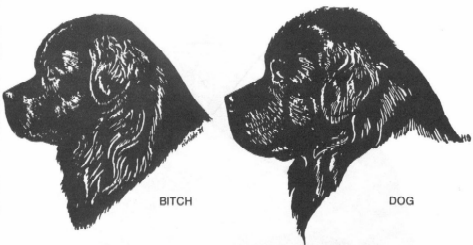FCI STANDARD
n. 50/24 July 1996 / GB (modified at the proposal of Switzerland and the Netherlands in June 1997)
Newfoundland dog
Origin: Canada
Patronage: FCI
Standard publication date:
24/7/1996

Utilization: heavy duty tow dog, water dog;
FCI classification : Group 2 Dogs, type Pinscher, Schnauzer, Molosser and Swiss Cattle
Section 2 -2 Molosser type mountain dogs without working trial.

General appearance : the Newfoundland dog is massive, with powerful trunk, well muscled and well coordinated in movement.
Important Proportions : The length of the body from the point of the shoulders to the point of the buttocks is bigger from the height to the withers. The body is compact. The female's body may be slightly longer and less massive than that of the male. The distance from the withers to the lower profile of the chest is lightly greater of the distance from the lower profile of the chest to the ground,
Behavior and temperament : The expression of the Newfoundland dog reflects benevolence and gentleness. Dignified, joyful and creative, he is recognized for his pure kindness and serenity.
Head : massive. The head of the female has the same general conformation as that of the male, but less massive.
Skull region :
Skull: Broad, with slightly arched dome and well developed occiput.
Stop: obvious but never abrupt.
Muzzle region:
Nose : large, well pigmented with well developed nostrils. Colors: black on black dogs or white / black, brown on brown dogs
Muzzle: Definitely square, deep and moderately short, covered with short fine hair, and free from wrinkles. The corners of the mouth are evident, but not overly pronounced.
Cheeks : soft.
Closing: scissor or pincer.
Eyes: relatively small, deep; spaced apart and must not show the conjunctiva. Color: dark brown for white / black or black dogs, a lighter shade is allowed for brown dogs.
Ears : Relatively small, triangular with rounded tips, set well back 5 on the sides of the head and close fitting. When the adult dog's ear is brought forward, it reaches the inner corner of the eye on the same side.
Neck: Strong, muscular, well set on the shoulders, long enough to allow a dignified posture of the head. The neck must not have an excess of dewlap.

Body: the skeleton is massive in all its parts. Seen in profile, the trunk is tall and vigorous. Straight top line; the back is firm from the withers to the rump. Broad back. Loin: Strong and well muscled. Croup: Broad, sloping so as to form an angle of about 30 °. Chest: Broad and deep. Ribs well sprung and well developed. Underline almost horizontal. The abdomen is never retracted.
Forelegs : They are straight and remain parallel to the walk and the small trot. Shoulders very muscular and well sloping. Elbows: Close to the body. Pasterns slightly sloping. Forefeet: Large, proportionate to the body, well rounded, with close and solid toes. The feet are webbed.
Hindquarters : in order for the dog to be able to pull loads, swim or cover a lot of ground effectively, (since the thrust depends largely on the rear), the conformation of the hindquarters in the Newfoundland is of primary importance. The pelvis must be strong, broad and long. Thigh: Broad and muscular. Knee well angulated, but not to the point of giving the impression that the dog is curled up under him. Legs strong and quite long. Hocks relatively short, well descended and well separated, parallel to each other. They are neither turned in nor out. Hind feet firm and closed. The spurs, if present, should be removed.
Tail: The tail acts as a rudder when the Newfoundland swims. As a result, the tail is strong and broad at the base. At the station, the queue hangs, possibly forming a slight curve at the end. It reaches the hock or slightly overtakes it. When the dog is in action or excited, it is carried straight with a slight upward curve. It is never curled over the back or curled forward between the legs.


Color: black, black and white, brown
• Black: the traditional color is black. The color must be as uniform as possible, but a slight bronze tint is allowed. White markings on the chest, toes and / or at the tip of the tail are allowed.
• Black and white: this variety has historical importance for the breed. Look for the following spots: black head with, preferably, a white stripe extending over the muzzle, a black saddle cloth with equally distributed spots and a black rump and black upper part of the tail. The other regions must be white and may have a minimum of flecks.
• Brown: this color ranges from chocolate to bronze. White markings on the chest, toes and / or at the tip of the tail are allowed. Brown subjects and black and white subjects will be presented in the same class as blacks.
Movement : The Newfoundland moves with a good reach of the forelimbs and a strong push from the hindquarters, giving the impression of effortless power. A slight roll of the back is natural. As the speed increases, the dog has a tendency to bring the limbs closer to a median plane ("single track"), while the top line remains horizontal.
COAT : Double coat, waterproof. The top coat is of medium length and straight, with no curls. Slight ripple is allowed. The undercoat is soft and dense, thicker in winter than in summer, but always present to some extent on the rump and chest. On the head, the muzzle and the ears, the hair is short and fine. The forelegs and hind limbs have fringes. The tail is completely covered with a long and dense hair but without forming a flag (without hanging fringes). Grooming is not to be encouraged.
